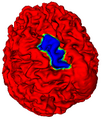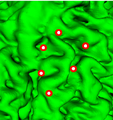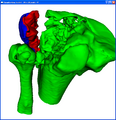2010 Winter Project Week SegmentationMeshEmbeddedContours
Key Investigators
- Georgia Tech: Peter Karasev, Matias Perez, Allen Tannenbaum
- BWH: Ron Kikinis
Objective
We are developing methods for segmentation of surfaces defined by polygonal meshes. In image or volume-slice segmentation, 'information' comes from image intensity, while in mesh surface segmentation the information is purely geometric. The goal of this project is to develop algorithms allowing a user to quickly and robustly segment one or several regions on a surface. Specifically, it is required to reconcile some concepts in classical differential geometry and embedded curves with the numerical and discrete-space constraints of polygon meshes.
Approach, Plan
Our approach for analyzing surface-embedded segmentation is separated into two parts. First, the notion of surface geometry for a polygonal mesh must be suitably defined. To this end, we study numerically stable and robust methods of estimating the geometry of the surface (mean curvature, tangent plane bases, second fundamental form, etc) and that of the segmenting curve. Second, we explore definitions of functionals whose extrema lead to useful geometric flows on the surface. The techniques for these two tasks must always consider the difficulty imposed by data purely in the form of a polygon mesh. This project makes extensive use of the VTK library to simplify data storage, communication, and visualization.
Our plan for the project week is to first come up with the best encapsulation framework for data storage and persistence, making the existing Slicer3 implementation feature-complete. Secondly, we seek to explore reformulation of existing image volume segmentation and mesh generation such that the numerical stability and accuracy of subsequent surface segmentation is taken into consideration.
Progress
A version of this software exists in Slicer3, with a standalone version being updated to encapsulate the functionality as a vtkPolyDataFilter. It has been experimentally verified to give useful segmentation results for meshes involving bone fractures (separating smooth non-fracture surface from jagged break zone). Some of the robustness issues (mesh connectivity, neighborhood sizes, differentiable basis functions) that have been seen to make a user experience inconsistent have been formulated as mathematical problems, allowing provable algorithm improvements to move forward.References
P.A. Karasev, J.G. Malcolm, M. Niethammer, R. Kikinis, A. Tannenbaum. User-Driven 3D Mesh Region Targeting. To appear in SPIE Medical Imaging 2010.




